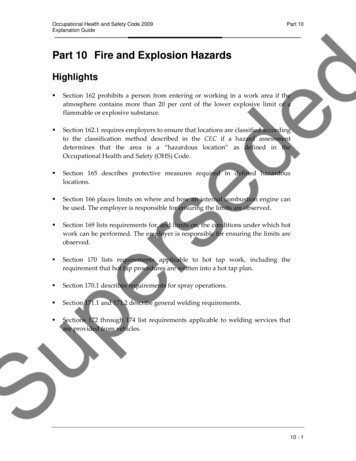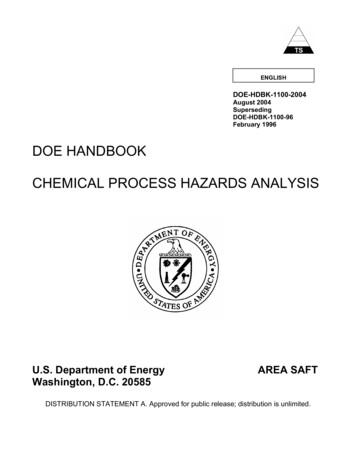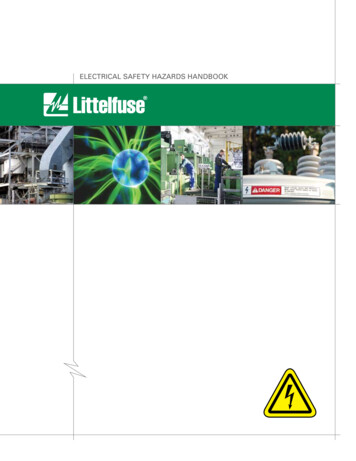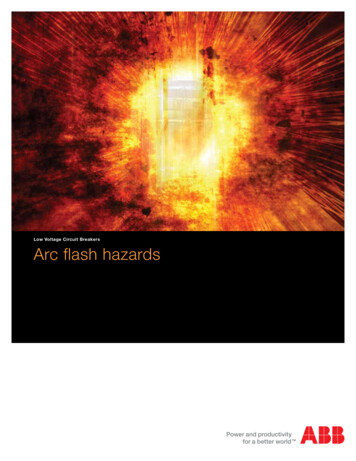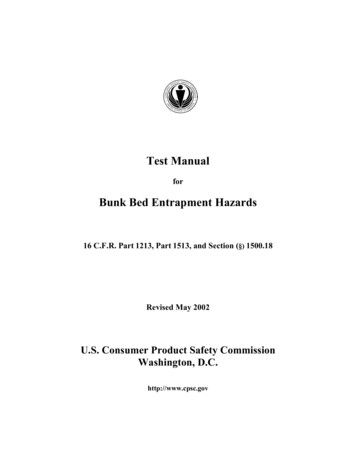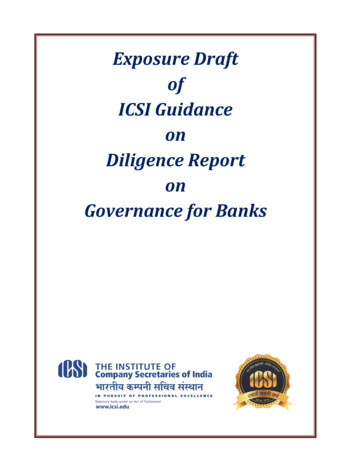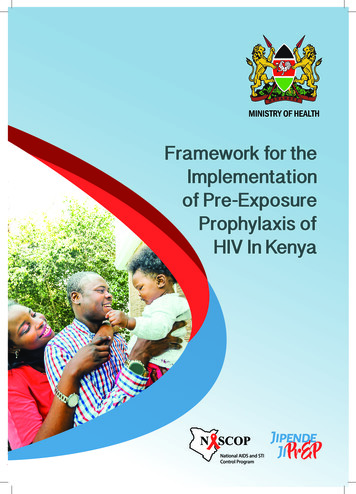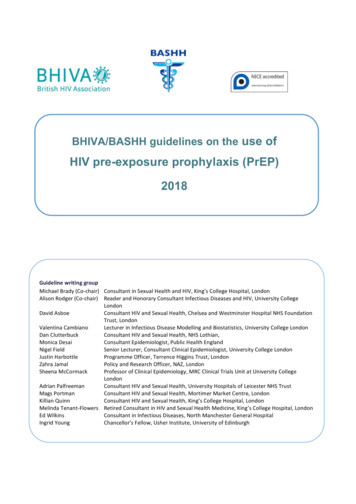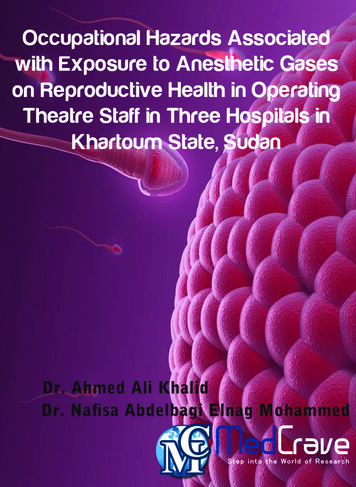
Transcription
Occupational Hazards Associated with Exposureto Anesthetic Gases on Reproductive Health inOperating Theatre Staff in Three Hospitals inKhartoum State, SudanDr. Nafisa Abdelbagi Elnag MohammedMBBS Khartoum UniversitySupervised by:Dr. Ahmed Ali KhalidAssistance Professor of Anesthesia, Umm AL-qura University College of Applied Medical Sciences, Department ofAnesthesia Technology, MD and MBBS fellowship smb,Omdurman Military Hospital, SudanPublished By:MedCrave Group LLCApril 29, 2016
Occupational Hazards Associated with Exposure to Anesthetic Gases on Reproductive Health in Operating Theatre Staff in ThreeHospitals in Khartoum State, ons3Abstract4Chapter One: Introduction5Chapter Two: Literature Review7Waste Anesthetic gases8Adverse health effects of occupational exposure to anesthetic gases10Reproductive toxicology of anesthetic gases11Recommendations and regulatory limits of anesthetic gas exposure13Methods of assessing exposure to anesthetic gases in the work place13The anesthetic machine15General workplace controls16Scavenging system and ventilation18Chapter Three: Methodology20Chapter Four: Results22Chapter Five: DiscussionChapter Six: Conclusion and Recommendations38Appendix16References40
Occupational Hazards Associated with Exposure to Anesthetic Gases on Reproductive Health in Operating Theatre Staff in ThreeHospitals in Khartoum State, SudanDedicationDedicated to all working mothers. especially my dear mother. for the sake of healthy babies.1
Occupational Hazards Associated with Exposure to Anesthetic Gases on Reproductive Health in Operating Theatre Staff in ThreeHospitals in Khartoum State, SudanAcknowledgementTo participate in our COMERRM111’dy by highly hiring important notices and research, the need for encouragement andtolerance is a priority which was given and very grateful to my family and friends. I am very thankful to my skilful supervisorDr. Ahmed P1111 Khaleol for his guidance, helpful thoughts and remarkable support 11 needed. Special thanks for thestatistician who had been very patient and cooperative, as well as EhHam Mohammed and Hadya Mohammed; thelibrarians in the Ministry of Health who had helped me a Hot. H greatly appreciate Shaza, the secretary and her friends fortheir help and support. Thanks to everyone who has been at my side during this bumpy journey.2
Occupational Hazards Associated with Exposure to Anesthetic Gases on Reproductive Health in Operating Theatre Staff in ThreeHospitals in Khartoum State, SudanAbbreviationsACGIH: American Conference of Governmental Industrial HygienistsAPL: Adjustable Pressure-LimitingASA: American Society of AnesthesiologistsCOSHH: Control of Substances Hazardous to Health RegulationsCPC: Chemical Protective ClothingDISS: Diameter Indexed Safety SystemECRI: Emergency Care Research InstituteETT: Endotracheal TubeFDA: Food and Drug AdministrationHVAC: Heating, Ventilating and Air ConditioningLMA: Laryngeal Mask AirwayNIOSH: National Institute for Occupational Safety and HealthOES: Occupational Exposure StandardsOR: Operating RoomOSHA: Occupational Safety and Health AdministrationsPACU: Post Anesthesia Care UnitPEEP: Pulmonary End Expiratory PressurePEL: Permissible Exposure LimitsPISS: Pin Index Safety Systemppm: Parts Per Millionpsig: Pressure Square Inch GauzePVA: Polyvinyl AlcoholREL: Recommend Exposure LimitTFA: Trifluoroacetic AcidTLV: Threshold Limit ValueTWA: Time-Weighted-AverageWAGs: Waste Anesthetic Gases3
Occupational Hazards Associated with Exposure to Anesthetic Gases on Reproductive Health in Operating Theatre Staff in ThreeHospitals in Khartoum State, SudanAbstractObjective: To assess the occupational hazard of unscavenged waste anesthetic gases on reproductive health (infertility,abortions, preterm delivery and congenital anomalies) in personnel working in operating rooms.Methods: The study was conducted by a questionnaire-based survey of 99 operating room personnel and 118 nonexposed personnel from the general wards in Omdurman Military Hospital, Omdurman Teaching Hospital and BahriTeaching Hospital. Controls selected by matching age, gender and job grade, 68 were eligible for analysis, 38 males & 30females. Single personnel and those working less than five years were excluded from the study.Results: Incidence of infertility in operating room personnel was 7.35% compared to 1.47% in non-exposed health workers(relative risk RR 4.93, 95% confidence interval: 0.6-41.7). There was a higher incidence of abortion in OR personnel inthe first ten years of work (43.3%) with (RR 3, (95% CI 0.8-11.93) while 14.29% in non-exposed health workers. Longerdurations of exposure were associated with having fewer children (0.05). Incidence of preterm delivery was similar in bothgroups (10% Vs 13.3%), but higher by about two-fold the general population (5%). Incidence of congenital anomalies inoffspring was similar in both groups (1.47%).Conclusion: There is a reproductive health risk of exposure to anesthetic gases. Adequate hazard control can be achievedby well-designed anesthetic equipment and high standards in scavenging and general ventilation and continuous trainingfor good work practices. All staff working with anesthetic agents and contemplating pregnancies should limit exposure totoxic substances to the lowest level achievable.Keywords: Occupational hazard; Waste anesthetic gases; Reproductive health4
Occupational Hazards Associated with Exposure to Anesthetic Gases on Reproductive Health in Operating Theatre Staff in ThreeHospitals in Khartoum State, SudanChapter 1Introduction5
Occupational Hazards Associated with Exposure to Anesthetic Gases on Reproductive Health in Operating Theatre Staff in ThreeHospitals in Khartoum State, SudanHealth care is one of the largest industries and fastestgrowing occupations. Health care workers face manywork place hazards; in addition to physical injuriessuch as needle stick injuries, back injuries and workplace stressors, they also run the risk of exposure toanesthetic waste gases, sterilant gases, solvents anddisinfectants [1].Anesthetic gases (such as nitrous oxide, halothane(Fluothane), Enflurane (Ethane), Isoflurane (Forane)can be released into work areas of the health carefacility: operating rooms, recovery rooms, labor anddelivery rooms, dental operatories and veterinaryclinics [2]. The anesthetic gases dispersed in operatingrooms ORs are considered as pollutants. They aredispersed into the environment through problems inthe equipment and from the exhalation of the patient[3]. Although healthcare workers are exposed to muchlower anesthetic concentrations than the patients,this exposure often extends over many years. Thedecisive factors as concerns the adverse health effectsof exposure to anesthetic gases are mainly the typeof gases used, the length of exposure, and the gasconcentrations [4]. Occupational exposure to anestheticgases has a wide range of health effects, includingneurological, renal and hepatic disease also reductionin mental performance and mental dexterity [5]. Theharmful effects to personnel from excessive exposure6to anesthetic gases have been documented in variousliteratures. Much serious disorders such as reducedfertility and problems during pregnancy are mentioned[4]. Scientific evidence obtained from human and animalstudies suggest that chronic exposure to anestheticgases increases the risk of spontaneous abortionsand congenital abnormalities in the offspring of femaleworkers and wives of male workers [6].To prevent unnecessary exposure to WAGs, protocolsand guidelines for workplace control have beendeveloped in the USA, UK and most European countriesby setting recommendations and regulatory limits. Itis also important to have good engineering control byscavenging systems and HVAC systems in the hospitalORs. Unfortunately, in most of the hospital ORs inSudan there are no scavenging systems, and thereforethere are minimal measures to prevent occupationalexposure to WAGs. As there are no published studiescovering this area of concern, this study was conductedto assess the reproductive effect of WAGs on healthcarepersonnel working in unscavenged ORs, includingrisk of infertility, misscarriage, preterm delivery andcongenital malformations of the offspring. Unfortunately,the levels of anestheic gases were not measured in theoperating rooms, but hopefully in further studies in thefuture it would be possible.
Occupational Hazards Associated with Exposure to Anesthetic Gases on Reproductive Health in Operating Theatre Staff in ThreeHospitals in Khartoum State, SudanChapter 2Literature Review7
Occupational Hazards Associated with Exposure to Anesthetic Gases on Reproductive Health in Operating Theatre Staff in ThreeHospitals in Khartoum State, SudanWaste Anesthetic GasesDefinitionWaste inhalation anesthetic gases and vapours are thosewhich are released into work areas (operating room,recovery room, delivery room, or other areas where workersmay be subject to job-related exposure) associated with,and adjacent to, the administration of a gas for anestheticpurposes, and include both gaseous and volatile liquidagents. Waste gases and vapours are here in referred toas waste anesthetic gases WAGs [7]. The waste anestheticgases and vapours that create health effects from overexposure include nitrous oxide and halogenated agentssuch as halothane, isoflurane, enflurane, trichloroethyleneand chloroform [1].non explosive and nonflammable, nitrous oxideis capable as oxygen of supporting combustion.Unlike the potent volatile agents, nitrous oxideis a gas at room temperature and ambientpressure. It can be kept as a liquid underpressure because its critical temperature liesabove room temperature [10] (Table 1).General InformationSurgical inhalation anesthesia was first used in the USwhen diethyl ether was administered to a patient in1842. Since then, many chemical compounds have beenused to anesthetize patients to keep them free from painduring surgical procedures. Many of the earlier inhalationanesthetics, such as diethyl ether and cyclopropane, areflammable and explosive and have been largely replacedby non-explosive, non flammable agents such as halothaneand methoxyflurane [7,8].It is estimated that more than 200,000 health anesthetists, surgical and obstetric nurses, operatingroom technicians, surgeons, anesthesia technicians, postanesthesia care nurses, dentists, dental assistants, dentalhygienists, veterinarians and their assistants, emergencyroom staff, and radiology department personnel, arepotentially exposed to waste anesthetic gases and are atrisk of occupational illness.Health-care workers in the recovery room encounteroccupational exposure to WAGs from the patients whichare eliminated by their respiratory system into the ambientenvironment [8]. Nitrous oxide will continue to be exhaledby the patient for up to one hour after the surgery is finished[3]. Exposure measurements taken in operating roomsduring the clinical administration of inhaled anestheticsindicate that waste gases can escape into the room air fromvarious components of the anesthesia delivery system. Ingeneral, the detection of halogenated anesthetic agentsby their odour would indicate the existence of very highlevels, as these agents do not have a strong odour at lowconcentrations. Hallen et al. [7] found that fewer than 50%of the population can detect the presence of halothaneuntil concentrations are 125 times the NIOSH REL(National Institute for Occupational Safety and Health, RELRecommended exposure limit) [8,9].a. Nitrous oxidei. Physical and chemical properties: Nitrousoxide (N20; laughing gas) is the only inorganicanesthetic gas in clinical use (Structure 1). It iscolorless and essentially odourless. Although8Structure 1: Structure of Nitrous oxide.Table 1: Physical properties of nitrous oxide [11].Molecular formulaN 20Molar mass44.013 g/molAppearancecolorless gasDensity1.977 g/L (gas)Melting point—90.86 C (182.29 K)Boiling point—88.48 C (184.67 K)Solubility in water0.15 g/100 ml (15 C)Solubilitysoluble in alcohol, ether, sulfuricacidVapour pressure5150 l Pa (20 C)Nitrous oxide gives rise to nitric oxide (NO) on reactionwith oxygen atoms, and this NO in turn reacts with ozone.As a result, it is the main naturally occurring regulator ofstratospheric ozone. It is also a major greenhouse gas andair pollutant.ii. Other uses: Nitrous oxide, in addition to itsuse as general anesthetic, is also used as anoxidizer in rocket motor racing to increase thepower output of engines. It is also approved asa food additive (E942), specifically as an aerosolspray propellant. Its most common uses in thiscontext are in aerosol whipped cream, canisters,cooking sprays, to inhibit bacterial growth, whenfilling packages of potatoes chips and othersimilar foods WI’.iii. Biotransformationandtoxicity:Duringemergence, almost all nitrous oxide is eliminatedby exhalation. A small amount diffuses outthrough the skin. Biotransformation is limited tothe less than 0.01% that undergoes reductive
Occupational Hazards Associated with Exposure to Anesthetic Gases on Reproductive Health in Operating Theatre Staff in ThreeHospitals in Khartoum State, Sudanmetabolism in the gastrointestinal tract byanaerobic bacteria. Nitrous oxide inhibitsenzymes that are vitamin B12 dependent byirreversibly oxidizing the cobalt atom in vitaminB12. These enzymes include methioninesynthetase, which is necessary for myelinformation, and thymidylate synthetase, whichis necessary for DNA synthesis. Prolongedexposure to anesthetic concentration of nitrousoxide can result in bone marrow depression(megaloblastic anemia) and even neurologicaldeficiencies (peripheral neuropathies andpernicious anemia). However, administrationof nitrous oxide for bone marrow harvestdoes not appear to affect the viability of bonemarrow mononuclear cells. Because of possibleteratogenic effects, nitrous oxide is often avoidedin patients who are pregnant. Nitrous oxidemay also alter the immunological response toinfection by affecting chemotaxis and motility ofpolymorphonuclear leukocytes [10].Postoperative hepatic dysfunction has several causes:viral hepatitis, impaired hepatic perfusion, preexisting liverdisease, hepatocyte hypoxia, sepsis, hemolysis, benignpostoperative intrahepatic cholestasis, and drug inducedhepatitis. Halothane hepatitis is extremely rare (1 per35, 000 cases). Patients exposed to multiple halothaneanesthetics at short intervals, middle-aged obese women,and persons with a familial predisposition to halothanetoxicity or a personal history of toxicity are considered to beat increased risk.c. Isofluranei. Physical properties: Isoflurane is a nonflammablevolatile anesthetic with a pungent ethereal odor.Although it is a chemical isomer of enflurane,it has different physicochemical properties(Structure 3).b. Halothanei. Physical properties: Halothane is a halogenatedalkane (Structure 2). The carbon-fluoride bondsare responsible for its nonflammable and nonexplosive nature. Thymol preservative andamber-colored bottles retard spontaneousoxidative decomposition. Halothane is the leastexpensive volatile anesthetic, and because of itssafety profile, continues to be used worldwide.Structure 3: Isoflurane (Forane) structure.ii. Biotransformation and toxicity: Isoflurane ismetabolized to trifluoroacetic acid. Althoughserum fluoride fluid levels may rise, nephrotoxicityis extremely unlikely even in the presence ofenzyme inducers.d. DesfluraneStructure 2: Structure of Halothane (Fluothane).ii. Biotransformation and toxicity: Halothane isoxidized in the liver by a particular isozymeof cytochrome P450 (2E1) to its principlemetabolite, trifluoroacetic acid. Bromide, anotheroxidative metabolite, has been incriminated inbut is an improbable cause of post anestheticchanges in mental status. In the absence ofoxygen, reductive metabolism may result in asmall amount of hepatotoxic end products thatcovalently bind to tissue macromolecules. Thisis more apt to occur following enzyme inductionby Phenobarbital. Elevated fluoride levels signalsignificant anaerobic metabolism.i. Physical properties: The structure of desfluraneis very similar to that of isoflurane, with the onlydifference of substitution of a fluorine atom forisoflurane’s chlorine atom. That “minor” changehas profound effects on the physical propertiesof the drug. The vapor pressure of desflurane at20 C is 681 mmHg, so at high altitudes it boils atroom temperature; this problem necessitated thedevelopment of a special desflurane vaporizer.Furthermore, the low solubility of desfluranein blood and body tissues causes a very rapidwashing and washout of anesthetic. Desfluraneis roughly one-fourth as potent as the othervolatile agents it is 17 times more potent thannitrous oxide (Structure 4).ii. Biotransformation and toxicity: Desfluraneundergoes minimal metabolism in humans.9
Occupational Hazards Associated with Exposure to Anesthetic Gases on Reproductive Health in Operating Theatre Staff in ThreeHospitals in Khartoum State, SudanSerum and urine inorganic fluoride levelsfollowing desflurane anesthesia are essentiallyunchanged from preanesthetic levels. Thereis insignificant percutaneous loss. Desflurane,more than other volatile anesthetics, is degradedby desiccated carbon dioxide absorbent(particularly barium hydroxide lime, but alsosodium and potassium hydroxide) into potentiallyclinically significant levels of carbon monoxide.The potential nephrotoxicity of the resulting rise in inorganicfluoride (F). Serum fluoride concentrations exceed 50pmol/Lin approximately 7% of patients who receive sevoflurane,yet clinically significant renal dysfunction has not beenassociated with sevoflurane anesthesia. The overallrate of sevoflurane metabolism is 5%, or 10 times that ofisoflurane. Nonetheless, there has been no associationwith peak fluoride levels following sevoflurane and anyrenal concentrating abnormality. Sevoflurane can also bedegraded into hydrogen fluoride by metal and environmentalimpurities present in manufacturing equipment, glass bottlepackaging, and anesthesia equipment. Hydrogen fluoridecan produce an acid burn on contact with respiratorymucosa [10].Adverse Health Effects of OccupationalExposure to Anesthetic GasesStructure 4: Desflurane (Suprane)e. Sevofluranei. Physical properties: Like desflurane, sevofluraneis halogenated with fluorine. Sevofluranecombines a solubility in blood slightly greater thandesflurane (Structure 5). Nonpungency and rapidincreases in alveolar anesthesia concentrationmake sevoflurane an excellent choice for smoothand rapid inhalation induction in pediatric andadult patients.Even in the early days of anesthesia, the dangers ofinhaled anesthetics to both patients and operating room(OR) personnel were recognized. Patients occasionallysuffered serious toxicity, such as hepatic failure, after theuse of chloroform, whereas OR personnel were at risk forfires and explosions with the use of ether and cyclopropane[12]. Occupational exposures to anesthetic gases involveconcentrations much smaller than those administered topatients in surgery. However, the side effects of anestheticgases on patients are of interest for purposes of preventingadverse health effects on health care workers who aregenerally exposed to these gases over many years whileworking in OR, recovery rooms, or in outpatient clinics [4].a. Central Nervous System: The effects of sedation andanalgesia sought for the patient may lead to undesirableeffects in the personnel exposed, especially when theconcentrations exceed current occupational exposurelimits. The following symptoms have been described,among others: fatigue, headache, dizziness,nervousness, nausea, concentration impairment andlacking fitness [4,12].b. Peripheral Nervous System: Peripheral neurop
Apr 29, 2016 · MedCrave Group LLC April 29, 2016. . Omdurman Teaching Hospital and Bahri Teaching Hospital. Controls selected by matching age, gender and job grade, 68 were eligible for analysis, 38 males & 30 . anesthesia care nurses, dentists, dental assistants, dental
